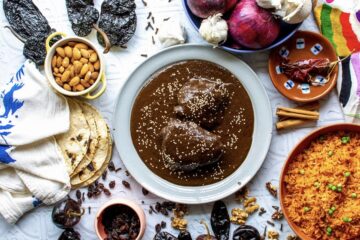Every December 8th, the Feast of the Immaculate Conception transforms towns across Mexico into vibrant celebrations of faith, tradition, and devotion to the Virgin Mary. When I was little, my family would travel to my mom’s hometown, Ojo Seco, where the entire community came together for what felt like one giant party centered around the Virgin Mary. It wasn’t just a religious event—it was a time of joy, family, and deep cultural connection.
What Is the Feast of the Immaculate Conception?
The Feast of the Immaculate Conception is one of the most important Marian celebrations in the Catholic Church. It honors the belief that the Virgin Mary was conceived without original sin, making her pure and worthy of being the mother of Jesus Christ. This doctrine was officially declared by Pope Pius IX in 1854, but devotion to Mary’s Immaculate Conception had been deeply rooted in Catholic tradition for centuries.
In Mexico, where Catholicism has been a dominant force since the Spanish colonization, this feast day has taken on a uniquely vibrant character. While it is an official holy day of obligation in many Catholic countries, in Mexico, it is also a day of cultural and community celebration.
A Celebration That Filled the Streets
In Ojo Seco, the Feast of the Immaculate Conception wasn’t just another church holiday. It was a day that brought the whole town together. The streets would be decorated with flowers, papel picado, and banners honoring the Virgin Mary. People prepared for weeks, planning processions, music, and meals to share with neighbors and visitors. For many families, including mine, this day was just as significant as Christmas or Easter.
Many Mexican towns have a deep-rooted devotion to Mary under various titles, such as Our Lady of Guadalupe and Our Lady of the Immaculate Conception. In places where the Immaculate Conception is the patroness, the celebration is even grander. In cities like Puebla, a historic center of Marian devotion, massive public celebrations include fireworks, concerts, and even fairs dedicated to the Virgin Mary.
Dressing Up for the Occasion
One of my earliest memories of the Feast of the Immaculate Conception was getting dressed up for church. My great-grandmother, who took this celebration very seriously, would have me and my older brother put on our best clothes. We always sat in the front pew, right where she wanted us to be. She believed that being as close as possible to the altar showed our devotion to the Virgin Mary.
My great-grandmother was also the loudest singer in the entire church. She sang every hymn at the top of her lungs, never missing a single word. As a child, I would sometimes feel embarrassed, but now, looking back, I admire her passion. Her faith was unwavering, and the Feast of the Immaculate Conception was her way of showing gratitude to the Virgin Mary for watching over our family.
How the Feast of the Immaculate Conception Became a Major Celebration in Mexico
The deep devotion to the Virgin Mary in Mexico can be traced back to Spanish missionaries who introduced Catholic traditions during the 16th century. The Immaculate Conception was a belief that resonated deeply with Indigenous peoples, who already had strong maternal figures in their spiritual traditions. Over time, these religious celebrations blended with local customs, creating the colorful and deeply meaningful festivities seen today.
While Our Lady of Guadalupe is the most famous Marian devotion in Mexico (celebrated just a few days later on December 12th), the Feast of the Immaculate Conception holds a special place in many communities. In some regions, the feast marks the beginning of the Christmas season, with special prayers, Masses, and public festivities.
In certain parts of Mexico, children dress up as little angels or wear blue and white clothing, symbolizing Mary’s purity. Families often hold novenas leading up to December 8th, praying the rosary together in preparation for the feast. It’s a time of reflection, gratitude, and asking for the Virgin Mary’s protection.
Processions, Fireworks, and Food
After Mass, the real celebration began. A long procession wound through the town, with people carrying statues of the Virgin Mary, candles, and banners. The air was filled with the sound of mariachi bands and church bells ringing. The Feast of the Immaculate Conception was not a quiet affair—it was full of life and energy.
As night fell, fireworks lit up the sky. Children ran around playing with sparklers while families gathered to share tamales, atole, and pan dulce. I remember sitting with my cousins, listening to the adults tell stories about past celebrations and how the tradition had been passed down for generations.
Why This Tradition Still Matters Today
For many in Mexico, the Feast of the Immaculate Conception is more than just a religious event—it’s a celebration of faith, unity, and cultural heritage. Even though I don’t get to spend every December 8th in Ojo Seco anymore, the memories of those celebrations stay with me.
Now, whenever I hear church bells ringing on the Feast of the Immaculate Conception, I think of my great-grandmother, singing her heart out in the front row, and the joy that filled the streets of my mom’s hometown. It’s a reminder that faith is not just about belief—it’s about the traditions, the people, and the memories that keep it alive.
For those who have never experienced the Feast of the Immaculate Conception in Mexico, I hope this glimpse into my childhood helps convey just how special this day is. Whether you celebrate with a grand procession or a simple prayer, this feast day continues to be a powerful reminder of the Virgin Mary’s presence in the lives of millions.


